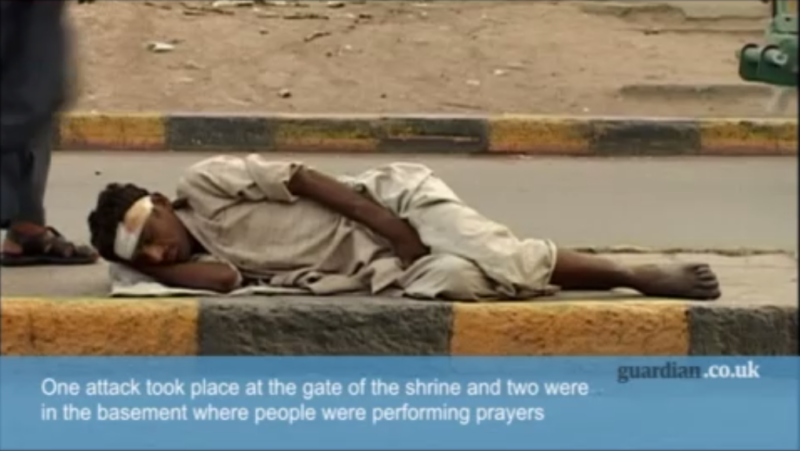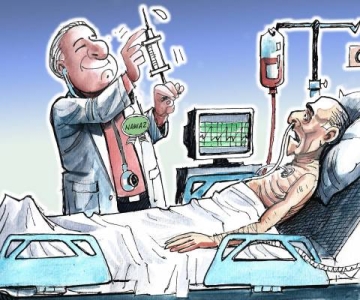Declan Walsh in Islamabad reporting for the Guardian
At least 42 killed and 175 injured in blasts at Sufi shrine in Lahore where thousands had gathered to pray
Suicide bombers devastated one of Pakistan’s most famous Sufi shrines last night, marking another vicious strike by violent extremists against the moderate form of Islam practised by most Pakistanis.
At least 42 people were killed and 175 injured when two bombers ripped through the Data Ganj Baksh shrine in central Lahore where thousands of people had gathered to pray, dance and listen to devotional music. The toll is expected to rise.
It was the second assault on a religious site in the city in recent months – an assault on members of the minority Ahmadi sect in late May killed 94 people – and underscored how extremists are determined to bring their bloody campaign to the heart of Punjab, Pakistan’s most populous and powerful province.
The ruthless mechanics of the bombing were captured on CCTV footage and aired on television. The first bomber ran into a basement area, clutching a bag filled with explosives and ball bearings and pursued by a guard, before a large explosion swept across the room.
As the smoke cleared a presumed second bomber is seen slipping into the building, against the tide of fleeing worshippers, and running up a staircase into the main area, where he also exploded himself.
Television footage and photos showed debris and body parts scattered across the blood-stained marble courtyard of the shrine.
Angy worshippers surged through the streets outside, throwing rocks at police and attacking television broadcast vans. Police fired shots in the air to calm the crowd.
The government is considering a new media law that would prevent television stations showing graphic images from suicide attacks.
Investigators said they had recovered the heads of both suicide bombers, but there was no claim of responsibility. The Lahore commissioner, Khusro Pervaiz, blamed the attack on a “conspiracy in which locals are being used” – a euphemism often used to point the finger at neighbouring India.
Some Lahore residents blamed the attacks on the US, saying its drone attacks in the frontier were provoking militants, while others suggested the Ahmadi community – which has no history of organised violence – was taking revenge.
The most likely culprits, however, come from within Punjab. A network of hardline madrasas scattered across the province, mostly in the southern belt, is home to thousands of religious extremists.
Politicians have vowed to crack down on the militant networks following a series of attacks targeting the Sri Lankan cricket team, intelligence and police offices, and busy market places in recent years. But little action has been taken while the provincial law minister, Rana Sanaullah, has attracted controversy for allying himself with Sipah-e-Sahaba, a Sunni extremist group.
The task of “draining the swamp” is further complicated by the powerful intelligence agencies of the military, which has continued its policy of distinguishing between “good” and “bad” jihadi groups – a policy that analysts warn is dangerously destabilising.
Last night’s deadly assault is not the first attack on Sufis. In March 2009 extremists in Peshawar blew up the shrine to Rahman Baba, the most celebrated Sufi of the north-west frontier region.
The glittering Data Ganj Baksh shrine is among Lahore’s most famous and revered landmarks. It is devoted to Hazrat Usman Hajwery, a 12th century mystic popularly considered to be the spiritual protector of the city.
The shrine is busiest on Thursday nights when worshippers come to pray, listen to qawalli devotional music and, in some cases, smoke hashish – which, presumably, is why extremists struck last night.
Ripples of outrage spread across the country, after a relatively quiet month with no attacks in Lahore in June.
“This is a barbaric attack and should serve as a wake up call,” wrote Raza Rumi, a prominent Lahore blogger. “Data Saheb’s shrine is not just another crowded place – it represents a millennia of tolerant Sufi Islam which is directly under attack by the puritans.”
Sufism is offensive to Muslims from the more ascetic Wahabbi and Deobandi sects, who consider worship of any saint to be heretical, and that the only access to God is through direct prayer.
This morning thousands of people flooded back into the mosque to offer funeral prayers for the dead.



